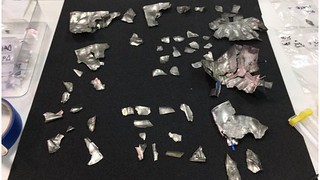
PREV ARTICLE
NEXT ARTICLE
FULL ISSUE
PREV FULL ISSUE
DETECTORIST UNCOVERS ROMAN HACKSILVER HOARDArthur Shippee forwarded this BBC News story about a significant recently discovered hoard of Roman silver in Scotland. -Editor
David Hall, from Livingston who is now 16, found the hacksilver in Fife when he was aged 14, in 2014. The silver was believed to have been used by Roman soldiers to bribe Picts while passing through Scotland. David said he did not initially realise the importance of the find and is excited to see how it now looks. The Dairsie hoard dates to the late 3rd century AD and is the earliest hacksilver from anywhere beyond the frontiers of the Roman Empire. The find has been hailed as "internationally significant" and will go on show for the first time in a new exhibition at the National Museum of Scotland in October. Hacksilver consists of silver objects hacked into pieces to make raw bullion. Archaeologists think the silver came to Fife as a gift or payment from the Roman world. The Romans could not just rely on the strength of their army - they also used diplomatic efforts to secure the empire's borders by buying off surrounding tribes. Curators have undertaken a daunting jigsaw puzzle, reconstructing four Roman vessels from more than 300 fragments, as well as examining how they had been cut into packages of bullion. To read the complete article, see: At first blush my decision was not to run this, because the hoard didn't include coinage. But I ran with it for two reasons. First, the cutting of silver plates and utensils into
smaller pieces for use in payment is very close to siege coinage, lacking only an official overstamp denoting an issuing authority and/or denomination. Second, the article introduced me to a new
word: hacksilver. Here's a handy Wikipedia definition. -Editor
Hacksilver or hacksilber, are fragments of cut and bent silver items treated as bullion, either for ease of carrying before melting down for re-use, or simply used as currency by weight. It was common among the Norsemen or Vikings, as a result of both their raiding and trade. Hacksilver may also have been used by Romans in their dealings with Pictish tribes. To read the complete article, see: Wayne Homren, Editor The Numismatic Bibliomania Society is a non-profit organization promoting numismatic literature. See our web site at coinbooks.org. To submit items for publication in The E-Sylum, write to the Editor at this address: whomren@gmail.com To subscribe go to: https://my.binhost.com/lists/listinfo/esylum All Rights Reserved. NBS Home Page Contact the NBS webmaster 
|
